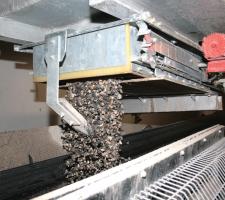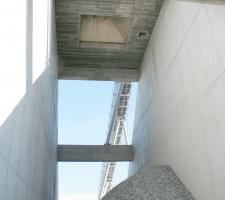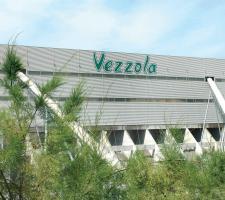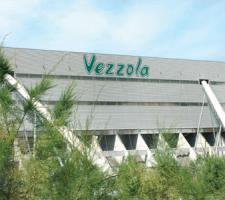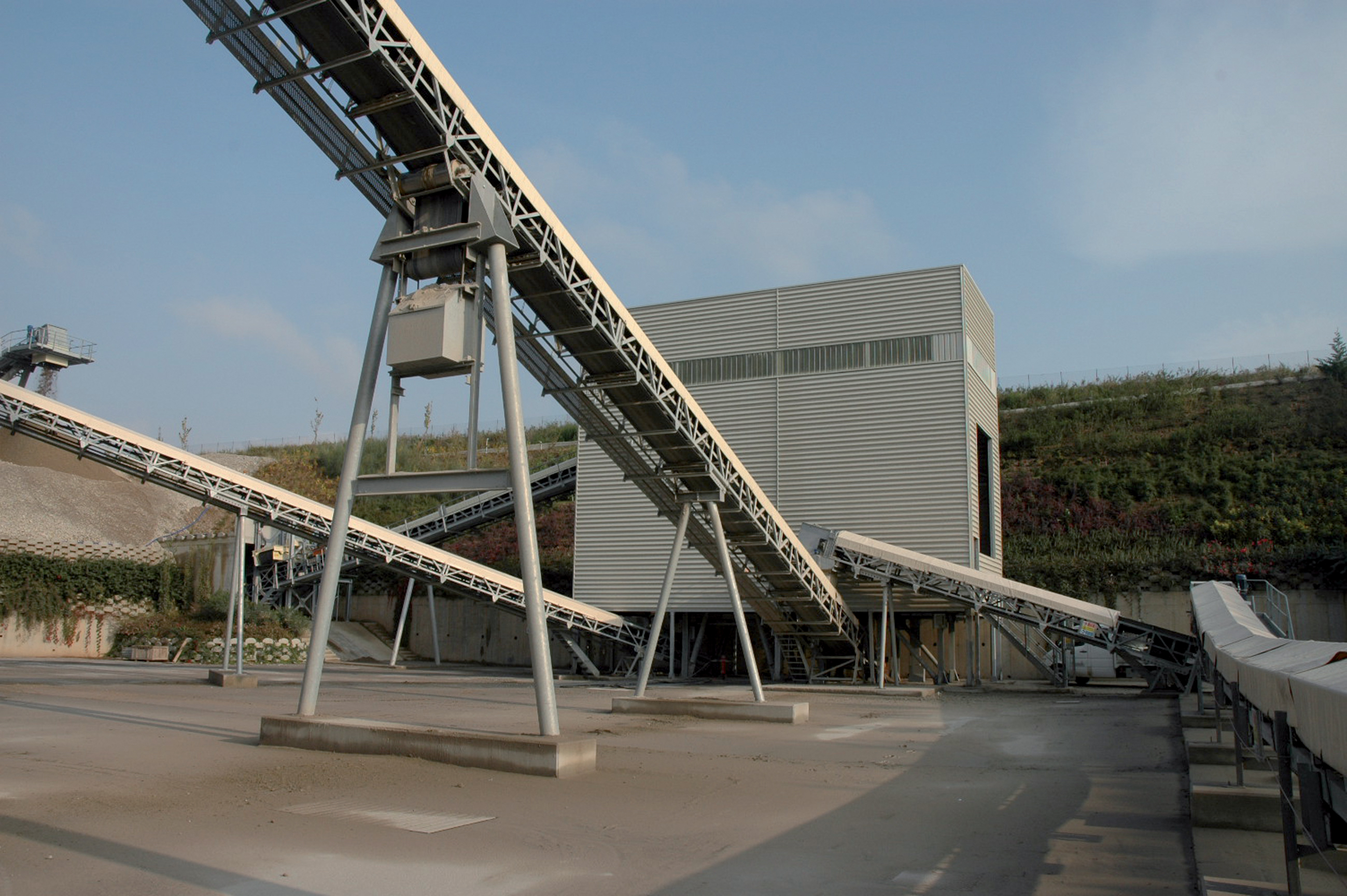
Family-owned quarry operator Vezzola is proving that there is still profit to be made from quarrying despite the economic downturn. Claire Symes visited the company's Montichiari plant to find out more
Over 2000 plants have been used to landscape the Montichiari site
The investment at Montichiari has been valued at €10million
The Lake Garda region of Italy is home to much of the country's sand and gravel production but limited quarrying consents means many of these are small operations. Nonetheless, there is one plant in Montichiari that breaks that trend with its sheer size and its industrial styled approach to aggregate production.
Proud owners of this modern facility are the
Family founders
Vezzola's quarry business was founded 42 years ago by Giovanni Vezzola, who is still president of the firm today, his brother Bernardo and father Valedio Gino. The firm started with a small sand and gravel quarry close to the shores of Lake Garda after the family recognised the growing need for aggregates in the region. That site is now closed but has been replaced with an ever expanding enterprise with the plant at Montichiari at its centre.
Today, despite a growing workforce of 120 employees, it is still very definitely a family-run operation with Giovanni's son Stefano undertaking the role of chief executive, his sister Christina heading up accounting operations and Stefano's wife Elena in charge of communication and marketing.
"The company's first proper quarry was the one at Lonato where our headquarters are, which exploits the local glacial deposits," explained Stefano. "However, the site is used more as a depot these days because of the limitations of being so close to Lake Garda making gaining permission to extend the site difficult. At the moment we are not working the consented reserves here but using the site to store material from our other quarries and to recycle slag for road construction and also process concrete demolition waste." The site also has a Marini asphalt plant to serve external customers as well as Vezzola's own road building contracts.
In addition to the plants at Lonato and Montichiari, the company also has aggregate processing facilities at Gussola and Manerda del Garda. In the last full financial year the company recorded a turnover of €53million and said that it expects the result for 2008 to be very similar with 13% of sales coming from its quarrying aggregates divisions.
Looking to the future Stefano said that he hopes his three sons, who are currently aged 15, 11 and 6, will follow him into the business. "I grew up in the company and worked in the quarry during the school holidays with my Grandfather (Valedio Gino) and produced the tickets for the lorries coming into collect material," he said.
"The quarry was part of every day life - when my Mother couldn't get away from work to collect me from football as a child I used to get a lift back home in one of the quarry trucks. I always wanted to work in the quarry - I know the business inside out and know the employees too, which I think is essential." Stefano did not join the quarry straight from school but undertook a diploma in geometry at the local school of construction followed his mandatory year of military national service. "When I did finally start work in the quarry, my first job was collecting payment from customers but I used to drive the delivery trucks when we were short of drivers," he explained. "After a year, my Father asked me what I wanted to do long-term in the quarry as he didn't want me to just drive a truck. From then on I had a diary and worked in the office more on the planning side of the operation but I still drive a truck every now and then - I think I will always be a truck driver at heart really.
"Having that experience of working in the quarry and having direct contact with the clients is very important as it means I have a good understanding of all the problems and issues that the business faces and can more effectively deal with them." After opening its first quarry in 1966, the company expanded into concrete production in 1972 before starting a construction division that was supplemented in 1985 by an asphalt production and road building operation.
Montichiari
Previously Vezzola had opted to use mobile plant within each of its quarries to process the material but the €10million investment in the Montichiari plant was a break from convention. Following a good experience with
"The plant was designed to cope with the industrial market for aggregates and we took a more industrial approach to the design of the sites," explained Vezzola chief executive Stefano Vezzola. "There are many quarries in the area but having one key plant for processing allows us to make better quality aggregates than our competitors and command a higher price in the open market." The hi-tech plant is located in a worked out area of the Montichiari quarry so it set down below ground level to minimise the visual impact of the enclosed crushing, screening and washing operations.
Industrial investment
In line with Vezzola's vision for an industrialised approach the asphalt hard standing was placed on the site ahead of construction with slopes designed to ensure fast surface water drainage that also enabled this rainwater to be collected and used for washing operations on site. As well as planting around the edge of the site to further screen the plant from the surrounding agricultural fields, the retaining walls within the site, including that for the surge pile, have been planted to soften the look of the site and make it a pleasant place to work. Stefano said a total of 2000 plants have been used to landscape the site.
The plant is designed to produce 13 different aggregate products at a capacity of 400tonnes per hour with a power consumption of 1300kW, but the computer controlled system can deliver 500 different mixes through automated programmes for concrete and asphalt mixes. These mixes can be loaded into customers trucks in under three minutes.
The site has 2500m2 areas, 17000m3 of storage, 750m of conveyors, which are all covered to minimise loss of fines and dust spreading onto neighbouring sites.
While Vezzola still has reserves at the Montichiari quarry, the plant also processes material from other small authorisation sites in the surrounding area - these are typical in Italy - and material is excavated and trucked to Montichiari.
Most authorities granting permission for quarries in Italy are local so they often don't give consent for large quarries as they are only willing to allow permission for material used by the local market. It is this political set-up that means consolidation by the global aggregate companies that has been seen elsewhere in Europe is not as widespread in Italy. As a result around 50% of aggregate production in Italy is still privately produced as it is difficult for the larger public companies to deliver the large-scale efficiency that has been profitable elsewhere.
It is this that also sets the Montichiari plant apart from others in Italy - with small consents most companies do not opt for such a large investment in equipment. As a whole Vezzola produces around 1million m3 of aggregates each year and 400,000m3 of that is produced at Montichiari. "Around 50% of our total production is sold to external customers," said Stefano. "But around 350,000m3 of the material produced at Montichiari is destined for the open market." The aggregates are such high quality that they are sold to construction projects within a 200km radius and fetch an average price of around €8.5/tonne for gravel and €10/tonne for sand.
Production
Whether material comes from an external quarry or the stockpile built up from production on site at Montichiari, the raw aggregates are loaded into the processing plant by a wheeled loader operating at ground level. The machine loads the material into a push feeder that removes any oversize material, which at Montichiari is classed as over 250mm.
The oversized material drops onto a stockpile ready for when Vezzola's Lokotrack crusher is brought in every two weeks or so to process the material.
Material passing the size test is then transferred to the surge pile from where it passes into the first covered screening and crushing house. Here the Metso 2050 screen separates off material over 35mm which passes into a Metso NP1213 impact crusher and then onto the conveyor for crushed rock aggregates, while the material below 35mm passes onto another covered conveyor for natural aggregates.
These two conveyors transfer the material into two different parts of the main crushing and screening plant to ensure the products remain separated.
The main building is a design feature in itself with elegant cable stays spanning the length of it. Vezzola's president Giovanni Vezzola was inspired to use this concept following a visit to Turin where he saw the design of the Olympic facilities there. But the cables are more than just decorative - they tie the main building structure to the concrete of the material bays below and provide the building with the necessary flexibility to cope with dynamic wind loading.
Panels used to construct the building do more than just shield the equipment from the elements and prevent dust emissions too - the panels have been used to reduce noise outside the plant. Screen mounts have also been made from rubber and polyurethane to further reduce noise and vibration.Presidential preference
Giovanni Vezzola, Vezzola founder and president, is also a past president of the Associazione Nazional Estrattori Produttori Lapidei ed Affini - the Italian national aggregates association - and has a long term view for the aggregate industry. "I have always believed that we have a duty to leave a trace of our passage that serves to bring improvement and development, whether little or large," he said. "As head of a growing company I have led a busy life but today I am fortunate to enjoy some tranquillity through having children and managers who share my passion and this gives me time to reflect. "Development of the Montichiari plant was greatly desired by me and I see an avante garde project that is futuristic and unique in the Italian landscape. But when I look at the finished project, I see other things too - I see the development of the industry from when our company started in 1966 and aggregate production was the result of a man's strength but today our 'aggregate factory' spares the sweat and hard work."Development of the plant at Montichiari was an ambitious objective but there are many more that I wish to realise for the company."Once inside the structure, the crushed rock aggregates are then passed over a Metso TS403 screen and any material over 20mm or under 5mm is passed through two VEM Venturelli impact crushers that were recycled from the previous Montichiari plant. Material passing through the tertiary crushers is placed back into the screens to screen off the 0-4mm straight into a hopper, while the rest of the material passes into a Metso Ellivar IV washing plant. Material over 4mm is then placed into storage but material under 4mm is put through an MS600/200 cyclone for further separation.
The natural aggregates are taken from the initial screening to the main processing unit into another Ellivar IV washer and again the under 4mm material is placed through a second MS600/200 cyclone.
Water used in the washing process and collected as surface water run off from the site's hardstanding areas is passed through the on site water treatment plant to allow it to be recycled. The treatment includes a filter press unit to ensure maximum water recovery and the filter cake formed from the removed fines is reused for restoration of worked areas of Vezzola's quarries.
Great attention has been paid to water retention as water usage is taxed so the Montichiari plant is designed to be as water efficient as possible. This attention extends to the use of a tiled channel below the aggregate storage bays to collect water and fines and channel them into a sump screw to separate the aggregate from the water.
Montichiari's operation is very lean with just four workers on site at the time of ABE's visit - one operating the wheeled loader, two carrying out site maintenance and one operating the control room. From the control room, delivery of the 500 different mixes can be delivered directly into customers' trucks or onto stockpiles for loading.
Economic impact
According to Stefano, the current downturn in demand for construction materials in Italy is giving the business a good opportunity to review its operations. "The break in the pace of growth is allowing us a moment for reflection and a chance to optimise and make changes to improve our prospects for the future," he said. "Each year we invest 600hours in training for all the workers in the company right from administration through to technical and mechanical roles. At the moment we are meeting on Saturdays to think and plan ways to improve the operation. Looking ahead there are still plenty of opportunities in public works projects." According to Stefano, the Vezzola company is not currently planning any further major investment in its quarrying operation but it is actively widening its business. "We have recently taken ownership of an asphalt planing company - this was in payment for debts that the owner of the company couldn't meet," Stefano explained. "Other companies that are not so well strategically structured are suffering but I think the Vezzola company is well positioned."



